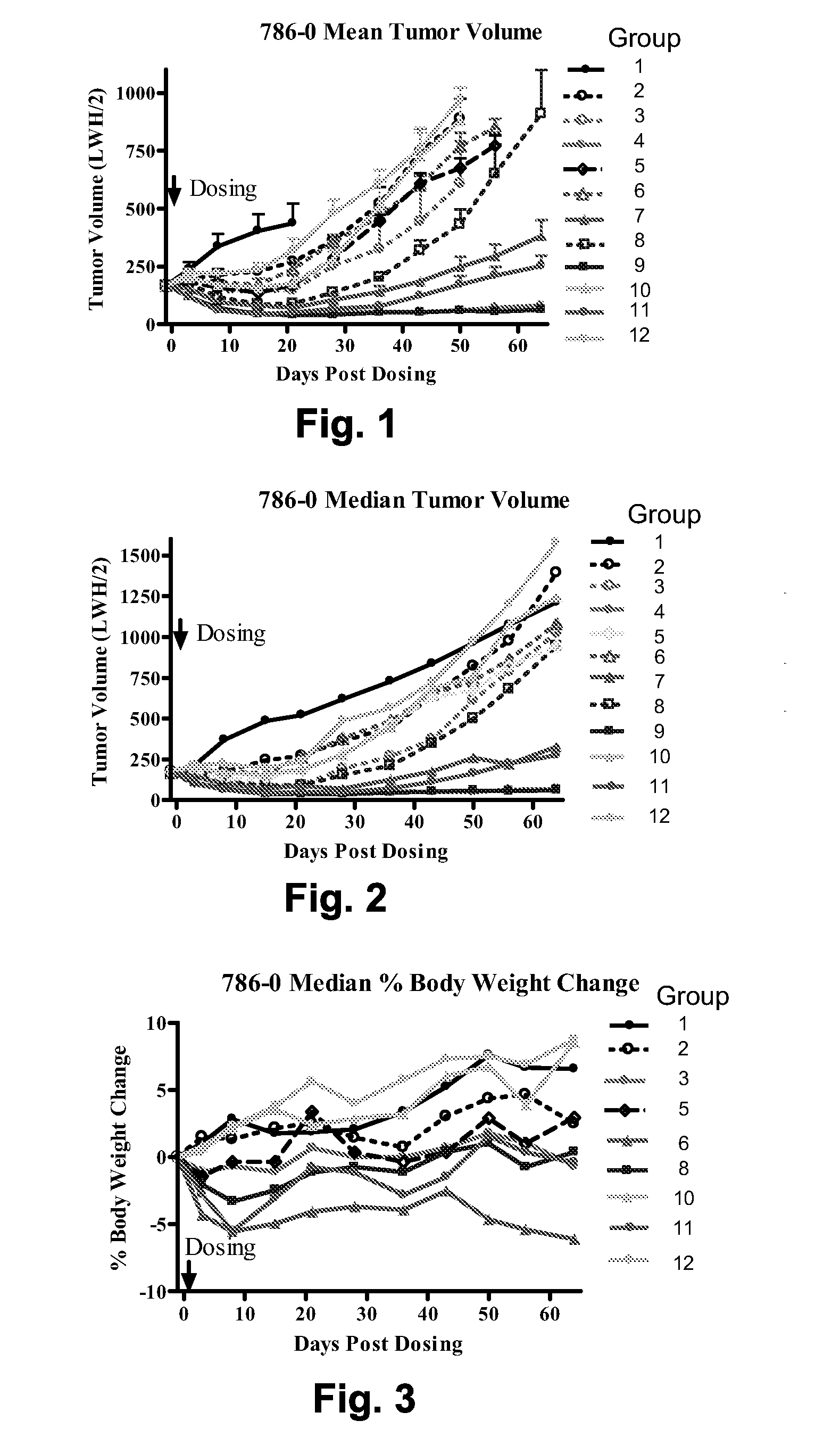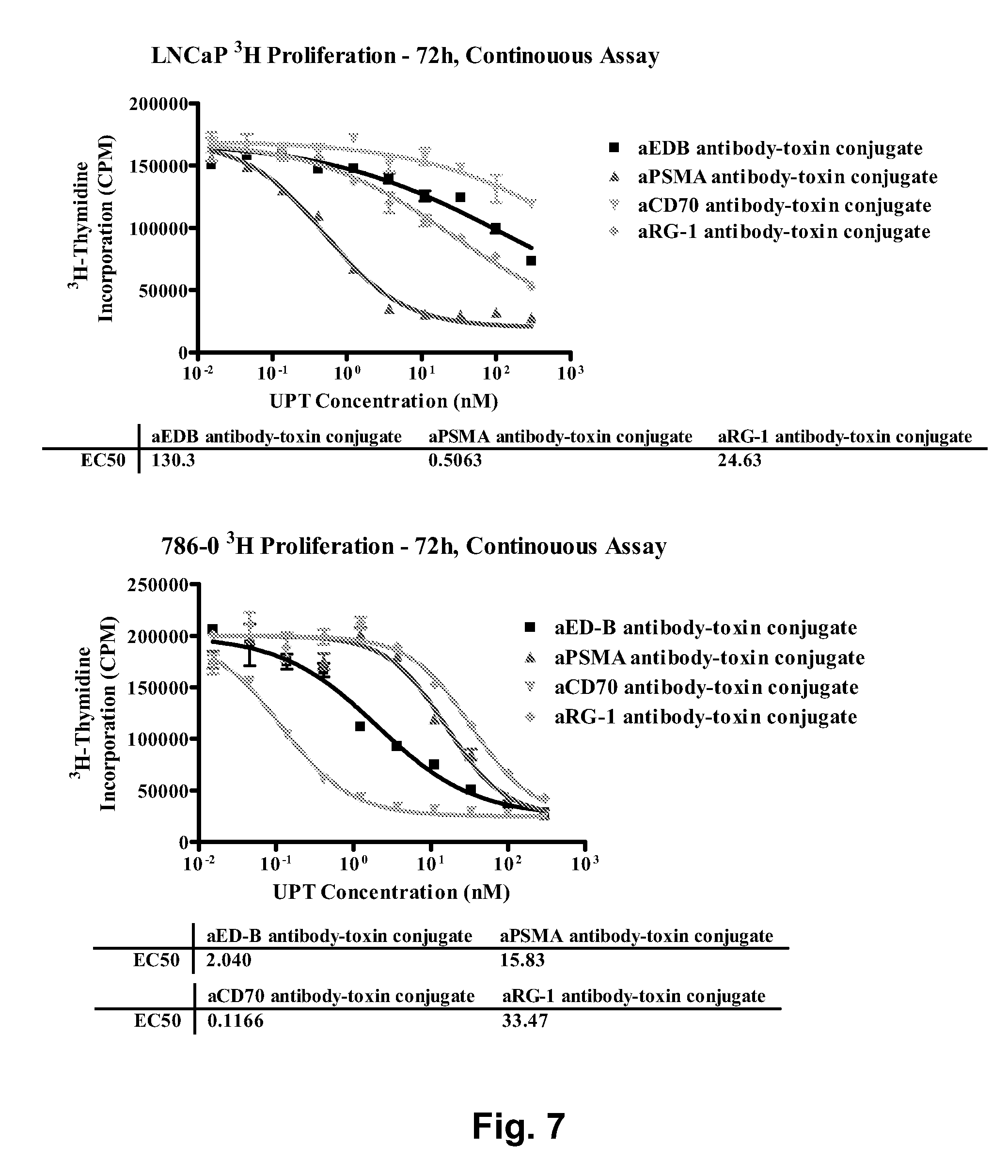Chemical linkers and cleavable substrates and conjugates thereof
a technology of chemical linkers and substrates, which is applied in the direction of peptides, drug compositions, peptides/protein ingredients, etc., can solve the problems of limiting application, affecting the stability of plasma, and often exhibiting acute toxicity in vivo, and achieve the effect of maximum efficacy
- Summary
- Abstract
- Description
- Claims
- Application Information
AI Technical Summary
Benefits of technology
Problems solved by technology
Method used
Image
Examples
example 1
[0651]
[0652]Synthesis of Compound 1: To a solution of 2-bromoethylamine bromide (5 g, 24.4 mmole) in DMF (50 mL) was added diisopropylethylamine (8.5 mL, 48.8 mmole) and benzyl chlroroformate (3.48 mL, 24.4 mmole). The mixture thus obtained was stirred at room temperature for 2 hours. The reaction mixture was concentrated and the residue was purified by flash chromatography on silica gel with ethyl acetate / hexanes (3 / 7) as gradient to give Compound 1 as an oil (4 g, 64%). 1H NMR (CDCl3) δ 3.54 (bs, 2H), 3.61 (bs, 2H), 5.12 (s, 2H), 7.36 (m, 5H).
[0653]Synthesis of Compound 2: To a solution of Compound 1 (3.34 g, 12.99 mmole) and valine tert-butyl ester (3.27 g, 15.59 mmole) in DMF (50 mL) was added potassium carbonate (5.39 g, 38.97 mmole) and potassium iodide (2.59 g, 15.59 mmole). The mixture thus obtained was stirred at 100° C. overnight. The reaction mixture was concentrated and the residue was purified by flash chromatography on silica gel with ethyl acetate / hexanes (2 / 8) as gra...
example 2
[0670]
[0671]Synthesis of Compound 16: To a solution of Fmoc-Cit-PABOH (2 g, 3.98 mmole) in DMF (45 mL) was added piperidine (5 mL) at room temperature. The mixture thus obtained was stirred at room temperature for 1 hour. The mixture was concentrated to dryness and then the residue was purified by flash chromatography on silica gel with 100% dichloromethane, followed by 10% methanol in dichloromethane and finally 30% methanol in dichloromethane as gradient to give H-Cit-PABOH as colorless oil (1 g, 90%).
[0672]To a solution of H-Cit-PABOH (80 mg, 0.28 mmole) in DMF (4 mL) were added the compound 5 (100 mg, 0.24 mmole) (see Example 1 for preparation), HATU (100 mg, 0.26 mmole) and diisopropylethylamine (125 μL, 0.84 mmole). The mixture thus obtained was stirred at room temperature for 1 hour. The solvent was evaporated and the residue was purified by semi-preparative HPLC to give the Compound 16 as an oil (119 mg, 66%). 1H NMR (CD3OD) δ 1.03-1.11 (2d, 6H), 1.58 (m, 2H), 1.77 (m, 1H), ...
example 3
[0682]
[0683]Synthesis of Compound 23: A solution of ethyl-5-nitroindole-2 carboxylate (2 g, 8.5 mmole) and palladium on charcoal (200 mg) in 50% methanol in dichloromethane (100 mL) was placed under hydrogen atmospheric pressure at room temperature. The mixture thus obtained was stirred at room temperature for 2 hours. The palladium was filtrated and the reaction mixture was concentrated to dryness to give Compound 23 as colorless oil (1.68 g, 97%). 1H NMR (CD3OD) δ 1.38 (t, 3H), 4.34 (q, 2H), 6.86 (dd, 1H), 6.95 (d, 1H), 6.98 (d, 1H), 7.25 (d, 1H).
[0684]Synthesis of Compound 24: To a solution of Compound 23 (300 mg, 1.47 mmole) in dichloromethane (5 mL) was added Boc2O (385 mg, 1.76 mmole). The mixture thus obtained was stirred at room temperature for 2 hours. The reaction mixture was concentrated and the residue was purified by flash chromatography on silica gel with 10% ethyl acetate in hexanes as gradient to give Compound 24 as a white solid (272 mg, 61%). 1H NMR (CD3OD) δ 1.39 ...
PUM
 Login to View More
Login to View More Abstract
Description
Claims
Application Information
 Login to View More
Login to View More - R&D
- Intellectual Property
- Life Sciences
- Materials
- Tech Scout
- Unparalleled Data Quality
- Higher Quality Content
- 60% Fewer Hallucinations
Browse by: Latest US Patents, China's latest patents, Technical Efficacy Thesaurus, Application Domain, Technology Topic, Popular Technical Reports.
© 2025 PatSnap. All rights reserved.Legal|Privacy policy|Modern Slavery Act Transparency Statement|Sitemap|About US| Contact US: help@patsnap.com



